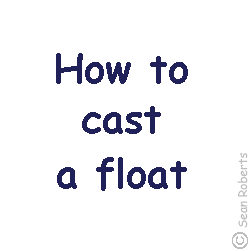INTRODUCING THE WAGGLER
Without doubt the one of most used rod and reel float in my tackle box! Probably accounting for more fish caught in one season, than any other fishing method I use. The waggler was developed for modern fishing quit late in the history annuls of fishing, it was only recognised as a truly deadly method for catching fish back in the early 1950s.
Who discovered or developed this method, is a debated question among angling historians, records show that a waggler form of an antenna float was first used in Holland, on the great canals, before the 1900s. Although many great names have been linked with its, modern day developments. Benny Ashurst, Billy Lane, Johny Moult, John Toulsant just to mention a few. The grandfather of match fishing the late Mr. J.H.R.Bazley won two National Championships (1909,1927) using bottom only floats.

The waggler was once called the waddled float, the story goes, that as the float was retrieved in the water, anglers would say it was waddling.
Peacock quills only came to our shores just after the Second World War and before the import of peacock quills, waggler floats, came in many other materials; swan quill, goose quill, porcupine, condor quill, crow quill, and even celluloid, which was perhaps the inauguration of the modern day plastic floats.
These days, wagglers are produced with high-tech precision, made out of clear plastics, graded peacock, sarcandas reed, nylon, tapered balsa, or a combination of each, coated in varnish or airship polythene paint, interchangeable tips and adaptors, with printed shot capacity on the side. Wagglers have certainly developed considerably, and within my Gold Medal Float Website, I hope to cover most of them. A waggler float comes in different lengths, they are attached to the main line by way of either an eye or by rubber adaptors. I prefer a silicone adaptor, and most of the wagglers I market have these attached. The float is locked by split shot on both sides, this is also where the bulk of the shot should be, giving the float weight and balance. Under the float on the line to the hook length should then go the remaining shots, these should be spaced out in such a way that they don’t tangle when casting. This is also where the presentation of the bait begins.
Finding the right size of waggler to use on a venue is very important, and this can only come with experience. The rule of thumb is not to use a bigger float than is reasonably necessary, yet light enough to cast into your swim. The float is so versatile and adaptable it can be used on most fishing venues, and because of the locking system, it can be moved up or down the line very easily, altering the depth to find the fish. One big advantage over most other floats is the ease of casting without tangling, and it can combat windy conditions.
Casting the waggler is best done over head, wind the float halfway up the rod, sight an object on the far bank or skyline, bring the rod back at a 45-degree angle, cast forward towards the object up into the air, release the reel line and as the float starts to decline then feather the reel with an index finger so that the shots on the line spread out in a straight line.

If you want to sink the line, just place the end of the rod into the water and retrieve a few feet. Casting the waggler from the side is a bit more complicated; it can be done with a bit of practice, simply hold the rod from your waist, holding on to the line above the bait, making the rod bend for a catapult action.
Now Available: The Complete Float Manual. Over 169 pages of content
